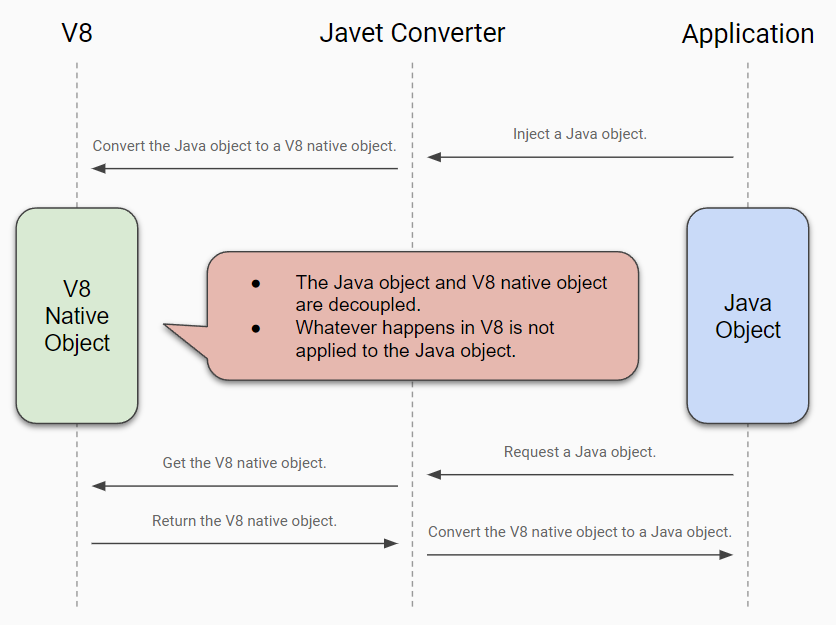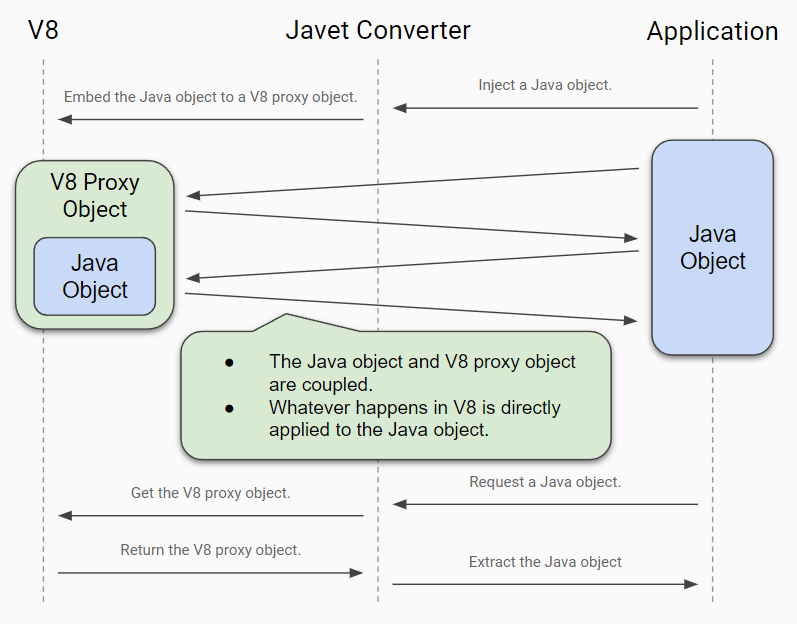Converters¶
Comparisons¶
Inside Converters¶
Binding via Native¶

Binding via Proxy¶

Null Safety¶
What if the object converter meets null or undefined when target type is primitive? This is a quite famous topic in Java because converting null to primitive type results in java.lang.NullPointerException. Luckily, Javet object converter is null safe by injecting default primitive values to JavetConverterConfig and these default primitive values can be overridden.
Functions and Objects¶
There are few challenges in the object conversion.
V8 functions cannot be easily represented by Java objects.
V8 objects and maps cannot be easily differentiated in Java.
Sometimes unexpected functions from object conversion may break applications.
So, Javet introduced IJavetEntityFunction and IJavetEntityMap so that V8 functions and V8 maps can be precisely represented in Java.
Also, JavetConverterConfig exposes setSkipFunctionInObject(boolean) and setExtractFunctionSourceCode(boolean) to give application the opportunity to skip functions in objects or extract source code of functions.
If the source code is provided to a user defined function, Javet object converter will inject that function from the source code automatically. That makes sure Java object from V8 object can be smoothly converted back to V8 object at both property and function levels.
Circular Structure¶
It is inefficient and inconvenient for Javet to substantially detect circular structure during object conversion. Instead, Javet converter keeps increasing the depth of recursion and throws JavetConverterException when maximum depth is reach. Maximum depth can be changed before object conversion is started. This is a cheap operation with high performance.
Please avoid setting maximum depth to an unrealistic number because JVM will throw StackOverflowError which brings considerable performance overhead. The thing worse than that is there will be memory leak because resource recycling logic written in finally block sometimes won't be called when stack overflow occurs. Attackers may easily drain the server resource in minutes by sending tiny circular structure data.
When does the Config Take Effect?¶
The config only takes effect when the actual conversion takes place. Once the binding between the JavaScript object and Java object is set, the config changes will no longer be applied to it by the converter. That behavior allows some fancy things to happen. E.g. a Java Map can be read-only in V8 when setProxyMapEnabled(false) is called whereas the next Java Map can be read-write in V8 when setProxyMapEnabled(true) is called.
Can Built-in Converter be Ignored?¶
Yes. One of the beauties of the built-in converter is it is convenient to bi-directionally convert arbitrary objects. However, sometimes applications want to take fine-grained control over every conversion. E.g. a needs to use JavetObjectConverter, b needs to use JavetProxyConverter, etc.
No worry. Applications may use any converter to convert Java objects to V8Value objects or vice versa. Javet API is able to accept V8Value and return V8Value. In this case, the built-in converter is ignored.